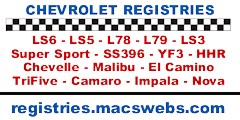Frequently Asked Questions & Dispelling Myths1967-1969 Gen 1 Camaro |
ChevyWorld.net
|
|
[Q]: Didn't all Z28-optioned Camaros come with
gauges? [A]: No. RPO U17, Front Compartment Console Instrument Cluster was an option on any V8 Camaro. This option was only available when the console option (RPO D55) was ordered and there were some limitations on the console option depending on the year . [Q]: What is all this RS and SS stuff? [A]: "RS" is short for Rally Sport, an option consisting of special features depending on the year. One unique feature of the "RS" option for all three years are hide-away headlamps. "SS" is short for Super Sport, a moniker Chevrolet has used since the 1961 model year for a specific group of options. Like the Rally Sport option, the Super Sport option included distinctive features, emblems, etc. depending on the particular year. These two options could be ordered separately or together. [Q]: Didn't all Z28s have "Z/28 " fender emblems? [A]: No. The Z28 was a "Special Performance Package" option which included, among other things, the 302 cid engine. The "Z28" code was initially just another regular production option (RPO) code and was introduced in December of 1966. The 1968 model year saw a "302" emblem on the front fenders that was later changed to "Z/28" to identify the option. The Z28 option could be ordered with the RS option as well but not with the SS option. The Chevrolet Camaro was built on GM's F-body platform and Chevrolet's response to the Ford Mustang. The Pontiac division of GM also had their version of this new model in the form of the Firebird. The Camaro could be ordered with a variety of engine from the 230 cid L6 to the mighty 396 cid V8 and, via the Central Office Production Order (COPO) system an all aluminum ZL1 427cid engine pumping out a rated 425hp. Camaros were (and still are) build in a 2+2 4-passenger seating arrangement. The car utilizes and front subframe with unitized rear (firewall back) as opposed to a full-frame construction used on other General Motors offerings. The majority of the first generation Camaros, about 75%, were built at the Norwood, Ohio assembly plant with the remaining units built at the Van Nuys, California assembly plant. The Norwood plant built Camaros for the central and eastern U.S. as well as most exports. The Van Nuys plant was intended for the western U.S. market. As was the custom in those days, the production year did not match a calendar year. Typically, new model year vehicles began assembly in August of the previous calendar year; meaning the 1967 model year Camaro began production in August of 1966 and ran through July of 1967. New cars were often readied for public sale around Labor Day of the previous calendar year. The one exception for Camaros (and several GM makes) was the 1969 production year. Due to issues with sheet metal the 1970 Camaro was delayed until February of 1970 as is often dubbed a 70 1/2 Camaro. This delay caused the 1969 model year Camaro to continue production through November at the Norwood facility. General Motors did not retain records of option combinations. While there are known figures for individual options, paint colors, interior trim, etc. it's impossible to know how many of any year was built (for example) painted black and equipped with a particular V8 and particular transmission. Certainly some options would be more popular in combination with others and that fact alone will skew any calculated figure for combination option production. If you have any specific questions, you can contact me via my contact link or check my CamaroWorld website. |
CDs/Coins/Gifts/Stickers
See more ChevelleCD Chevy-related products here ↓
Mac's Registries
See more about Chevrolet/Camaro/Monte Carlo/Nova/HHR/SSR/Acadian/Beaumont registries here ↓ |
|
|
|





